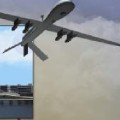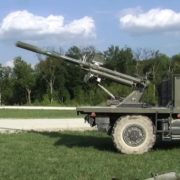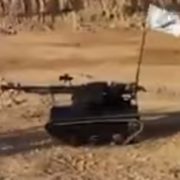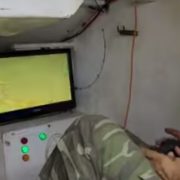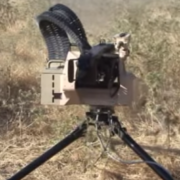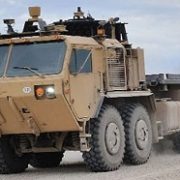Every summer, I have a front-row seat to hell. I live at the foothills of the San Gabriel Mountains, just east of Los Angeles. During this time of year I can walk out of my house and see hills pockmarked by flames, as if they were covered by the campfires of an invading hoard. All […]
Recently, I was asked to answer a question on the social media site Quora. I was asked, “How does a person get their robot design/prototype bought by the U.S. military?” Here is my answer:
This is one of those “if you have to ask, forget about it” questions. Selling to the American military is a world in itself, and your best bet is to partner with someone who has direct experience with Defense acquisition.
I work for AMREL (American Reliance). It makes rugged computers that are the platforms for Operator Control Units for Unmanned Ground Vehicles (UGV). While I have never directly dealt with military procurement, I have had many conversations with salesmen who have.
Keeping in mind that I am not an expert, this is my general impression of what is involved:
- Target the specific bureaucracy: What kind of unmanned system you make will determine who you sell it to. ARMY likes Tactical Unmanned Aerial Vehicles (TUAV). The NAVY’s Advanced Explosive Ordnance Disposal Robotic System (AEODRS) is responsible for IED-detecting UGVs. The AIR FORCE flies the big Predator drones that you hear so much about in the news. (BTW, as you can tell from this paragraph, be prepared to learn acronyms. LOTS of acronyms.)
Keep in mind that the Department of Defense (DoD) is a bit like the universe, i.e. big, mysterious, and mostly invisible. Finding out who might want to buy your robot and who is the appropriate person to contact can be challenging.
- Ninety percent of sales is listening: Nowhere is this more true than in military sales. I don’t care if your robot can travel backwards in time, and makes non-fattening chocolate cake; if it doesn’t meet their requirements, the DoD is not interested. Find out what THEY want and then make it. From time to time, various elements of military hold public events that vendors can attend. Sometimes it’s just a table-top tradeshow or big-time demos like the Robot Rodeo. These are valuable places to gain info. Do a net search, plan your travel itinerary, print up some datasheets, and above all LISTEN.
- Be prepared to make changes, LOTS of changes: If the military is interested in your robot, it will go through an enormous amount of testing and approvals. This can take quite a bit of time. Large weapon systems have been known to spend decades in development. With every stage, you will receive feedback about what needs to be altered. End-user feedback is considered especially critical.
- Be prepared to spend money: Traveling around the country and preparing the appropriate documentation are expensive undertakings. And that’s not even counting the expense of multiple prototypes. AMREL has carved out a niche for itself in customizations of rugged computers for low volume orders with low-to-no NRE. This enables developers to make economical prototypes for the reiterative development process.
- You may end up selling to a big Defense contractor, rather than directly to the DoD. These guys are called “primes.” If you are making a garlic-sniffing submersible unmanned system, and Fat Cat, inc. holds the contract for this kind of robot, you have to sell to them. Just as you need to learn the intricate labyrinthine ways of the DoD, you are going to have to study the quaint and colorful traditions of Fat Cat if you want to do business with them. There are advantages and disadvantages to selling to primes, which is a whole other answer.
- Be prepared to spend lots of time. I was at a conference in which about half a dozen representatives of Defense primes were up on a stage answering questions. When asked “How long does it take to get a contract,” the average answer was 5 years.
- Make your robot cheap. The DoD may have more money than anyone else, but it’s under enormous pressure to be economical. They want solutions that save money.
- Can you buy parts for your robots off the shelf? The DoD used to spend big bucks on specialty items. Not anymore. They want to buy parts at the local big box store. The magic word is “Commercial Off The Shelf (COTS).”
- Does your robot work and play well with others? In this case, the magic word is “interoperability.” AMREL has been able to dominate the OCU market, because we came up with an interoperable solution that worked on multiple UGVs. Other companies created proprietary control systems that worked only on one robot. This caused a logistical nightmare for the DoD.
- Don’t believe the headlines about corruption and incompetence. Yes, the Defense procurement process is a mess. Why is a whole other answer. But it’s not the fault of typical DoD personnel. By and large the people you encounter in the military and Defense are smart, dedicated, and honest. They are haunted by the specter that the equipment they procure may result in the death of American servicemen. If you have a product that can save lives, then you might just have yourself a sale.
Built by the Mandus Group, the Hawkeye 105mm Weapon System is a revolutionary system that decreases recoil by 70% without degradation of performance. Recoil is dissipated by a hybrid of the traditional oil & gas system and what is known as a “soft recoil” system. Watch the video below to see the mobile howitzer in action.
Notice that before the Hawkeye discharges, the barrel is cocked slightly forward. This is part of the “soft recoil” control.
Recoil is so reduced that the Hawkeye can be mounted on a truck with only four bolts. The lack of recoil (and light weight) means the Hawkeye can be used on a wide variety of military vehicles including those that are wheeled, tracked, towed as well as rail, watercraft, and aircraft.
This mobile, powerful weapon is controlled by AMREL’s ROCKY DK10 Rugged Tablet. The Mandus group chose this 12.1” tablet because they needed modifications for a low volume order, which is AMREL’s specialty.
In order to be the Hawkeye’s Operational Control Unit (OCU), the DK10 tablet was modified to have thumbwheel connectors and joysticks. The DK10 OCU:
- Issues elevation and transverse commands
- Manages sensors
- Engages the safety system
- Enters firing missions & controls direct fire
- Interacts with laser range finder
- Interfaces with internal navigation system and electrical control box
In addition to functioning as a handheld control unit, the DK10 can be used in cab for navigation.
To learn more about AMREL customized table solutions, click here.
The United States relies on its technological edge for military superiority. The problem with that strategy is that eventually everyone gets their hands on the latest technological advance.
The Shi’ite militias in Iraq do not have their hands on the latest, but they did get a hold of a UGV. Obviously not fans of science fiction (otherwise they would know that armed robots always turn on their human masters), they went ahead and put a gun on this lumbering, exposed platform. War on the Rocks is less than impressed with this device, citing deficiencies in optics, wheels, and armor (the latter being nonexistent).
The Ground Combat Vehicle (GCV) doesn’t look particularly fearsome. It’s slow, clumsy, vulnerable, and looks like it’s dependent on line-of-sight for control. The Operator Control Unit (OCU) is a fragile looking commercial tablet, not the usual AMREL-made rugged OCU, which was a common sight in the Iraqi theater.
[layerslider id=”31″]
The militia does have the good sense to use a UGV for its intended purpose, i.e. IED detection. You can check the whole thing out in the video below. I recommend fast forwarding to the 2 minute mark, and turning the sound off, unless you understand Arabic (Farsi?) and are a fan of cheesy jihadist music
Thanks to Islamic State, the IED danger has just gotten worst in Iraq, one of the most heavily mined countries in the world. The following story originally appeared in the Counter-IED Report.
ISIS’s latest threat: laying landmines
Militants from the group calling itself Islamic State (IS) are booby-trapping land and buildings with improvised explosive device (IEDs), creating new misery for displaced Iraqi families trying to return home and adding to dangers for government forces working on the front line.
Last week four mine clearance workers died and two were seriously injured when an IED detonated in a house in Zummar, close to Mosul Dam in Nineveh Governorate, in northern Iraq.
Witnesses said the opening of a bathroom door triggered an explosion causing the property to collapse, instantly killing the men. The group, employed by the Iraqi Kurdistan Mine Action Agency (IKMAA), run by the semi-autonomous Kurdistan Regional Government (KRG), were working alongside the Peshmerga, the Kurdish military, who had recently won back the territory from IS.
Aid agencies are warning displaced Iraqis not to rush home to territory reclaimed from IS because of the risk of mines and other explosive remnants of war (ERWs) and have expressed concerns about mined borders areas between different military front lines.
“Large numbers of people are at significant risk,” said Nina Seecharan, Iraq country director for UK-based Mines Advisory Group (MAG) in the Kurdistan capital Erbil.
Omer Hassan, a commercial deminer who went to the scene of the 29 October explosion to help survivors of the accident, said: “There is an immediate need to mark villages like Zummar that are full of dangers,” referring to red posts and flags used by clearance teams.
Hassan, who lost his leg in a landmine accident some 20 years ago and who has dedicated his life to demining, said IS was using crude home-made devices that were easily mistaken for other things.
“They can make booby-traps with everything,” explained Hassan. “You can find a brand-new torch. [IS] knows the Peshmerga need it, so they leave them. The Peshmerga picks it up, turns it on…” The torches are packed with explosives. “You can lose a hand,” said Hassan.
Iraq is one of the most heavily mined countries in the world due to decades of conflict and territorial disputes.
According to the Landmine Monitor, an affiliate of the International Campaign to Ban Landmines (ICBL), the most-recently available statistics show up to 1,838sqkm of Iraqi territory is contaminated.
History repeating itself
In recent years intensive efforts to clear up ERWs mean most residential areas are now mine-free, and the bulk of remaining clearance operations are along mountainous border regions between Iran and Turkey where various armed groups had military posts.
However, thanks to IS, landmines are once again a very real danger for Iraqis, and not just in Kurdistan.
According to a 31 October report by the UN Office for the Coordination of Humanitarian Affairs (OCHA), as many as 3,000 ERWs and landmines were scattered across the town of Jurf al-Sakhr in Babil Governorate by a retreating IS.
“The issue of landmines is a major concern for us and one we urgently need to address,” said OCHA spokesman David Swanson.
Ako Aziz, the director of Mine Risk Education at IKMAA, said full details of what happened at the property in Zummar were still to be determined and an investigation had been launched.
He told IRIN that while the team was highly experienced, with some members having up to 15 years in the sector working on marked minefields and clearing ERWs from Iraq’s previous conflicts, they were not used to clearing houses of booby-traps.
“Our deminers are not specialized in IEDs, and need more training and experience,” he said.
“[IS] are very technical in laying out IEDs. They use many different ways and types of IEDs and a very high quality of explosives,” Aziz said. “This is the biggest challenge to the Peshmerga, as [IS] are booby-trapping all areas under their control.”
Raising awareness among the displaced
MAG, the only international humanitarian demining NGO left doing clearance work in Kurdistan, has been running awareness-raising sessions with displaced Iraqi families since June, when IS seized control of Mosul – forcing 600,000 people to flee in a matter of days.
“We’ve been working with displaced families to make them aware of the potential dangers, now and for when they return home,” MAG’s Seecharan explained. “Children who are naturally inquisitive and unable to read danger signs are particularly at risk.”
She said, however, that MAG clearance teams could not assist the military in their clearance operations because their remit was only humanitarian.
“While MAG’s imperative is to take action to prevent harm to civilians and civilian demining personnel, there has to be a clear line between humanitarian clearance in areas where active hostilities have ceased, and activities in support of ongoing military operations,” she said.
There are around a dozen commercial demining operators working in Iraq, including some international firms. Many are contracted by oil and gas companies clearing land for exploration, though some are also working for the government preparing for infrastructure projects and national parks.
Although the expertise is available in country to help the Iraqi authorities clear up the ERWs, the long-running budget dispute between Baghdad and Erbil means Kurdistan does not have sufficient money to take on new contractors.
Iraq also has an obligation to clear all of its landmines by 2018, having signed the Ottawa Anti-Personnel Mine Ban Treat in 2007. For some time this target has seemed ambitious, even more so now with so many new devices being laid by IS.
A report by the Landmine Monitor in August 2013, citing the most-recent statistics from Iraqi government agencies, said that since the late 1980s more than 29,000 people have been victims of landmine accidents in the country.
Nearly 15,000 of those casualties – including 6,000 deaths – were in Kurdistan.
In 2012, the latest year for which data is available, there were 84 mine accidents across Iraq with 42 deaths, though many more incidents are likely to have gone unreported. Since 2012, 11 deminers have lost their lives in clearance accidents across Kurdistan, IKMAA said.
When you play a first-person shooter game, did you ever wish you were firing a real gun? In a real war? These plucky Free Syrian Army (FSA) rebels made this fantasy real. Their homemade tank has a .50 machine gun whose Operator Control Unit (OCU) is a PlayStation controller. Look out Assad and ISIL; the FSA has guys who play video games.
[layerslider id=”33″]
As the violent images of Ferguson, Missouri permeate the media, a debate has erupted about the “militarization of police.” Strangely, this controversy might affect the utilization of Unmanned Ground Vehicles (UGV) by Public Safety departments. The same federal program – Defense Logistics Agency (DLA) 1033 – that delivers riot shields and automatic weapons to police departments for free, also distributes UGVs.
Basically, the feds are transferring extraneous equipment, including UGVs, from the military to the police. Cash-strapped police departments love this. Others not so much.
Some UGV developers have complained that the free robots dampen their market. Others in the unmanned community have pooh-poohed this idea by claiming that the UGVs being offered by the 1033 program are old, obsolete and/or too banged up to be of value.
Many (including some police officers) have been attacking this military-to-police transfer of equipment. They claim that supplying even small, rural departments with automatic weapons and other SWAT staples has led to a more violent, confrontational attitude among the police. A good example of this argument is One Nation Under SWAT, which appeared on Salon.com. (This Salon article does not reflect the opinions of AMREL, the blog, our partners, or our clients. We are linking to it, because we believe that people in the unmanned and Law Enforcement communities should know what is being said in this controversy.)
[layerslider id=”31″]
UGVs, whose only role is to save lives, are likely to be put in the same category as other “militarized” equipment. Knowing the way Washington works, if the 1033 program is scrapped, the era of free UGVs would be over.
AMREL has a number of employees who have experience in the Law Enforcement community. I sent the Salon article to them. This is the reaction of some of them to the “militarization of police” controversy.
- One former officer told me that the militarization of the police is real. It used to be that the only officers that were heavily armed were the ones that belonged to small specialty teams. Most people practiced “community” policing. Now, that situation is reversed.
- There is an arms race between criminals and the police. I heard several stories of times when the police were outgunned. This has led to a preference for lighter, larger caliber weapons.
- Cops like the military-to-police program. “We need automatic weapons,” said one former officer.
So, the essential point of the Salon article is wrong. The distribution of military equipment has not led to a militarization of police. Rather, a militarization of police has led to the acquisition of military weapons.
As unfair as it might be, this debate is likely to affect the acquisition of UGVs by police. Members of the unmanned community would be wise to keep an eye on this issue.
AMREL is the leader in providing Operator Control Units (OCU) for UGVs.
To learn more, contact Rob Culver at robertc@amrel.com or (603) 325 3376
UPDATE:
After reading this blog post, AMREL’s Senior Application Engineer, Javier Camarillo, confirms the suspicions of the low quality of the free UGVs. “I get calls all the time from small police departments, often from non-technical people. They view UGVs as complicated systems with attachments and accessories. They can’t get the them to work, and they can’t afford the parts they need. Sometimes, parts for the older UGVs are unavailable at any price.”
Maybe the 1033 program is actually hindering the adoption of UGVs by Public Safety officials. After all, the distribution of poorly performing equipment is teaching a generation of officers that UGVs are unreliable, expensive to support, and difficult to repair. For a discussion about the cost and value of UGVs, see an earlier blog post, UGV cost & why they should have leather seats.
Check out this video of a remote-controlled .50 caliber M2. About 35 seconds in, you will notice the dual-screen mobile weapons control station. Nicknamed “the DK Flipper,” this fully rugged tablet has a separate display for power and video input. This customized DK10 tablet acts as a force multiplier by enabling a single person to control several Remotely Operated Weapon Stations (ROWS). Learn more at AMREL’s tablet customization page.
[layerslider id=”32″]
 Recently, there has been a bit of press about a Capabilities Advancement Demonstration of autonomous vehicles at TARDEC (Tank-Automotive Research, Development and Engineering Center). My favorite headline about the demo so far is Is the U.S. developing a ROBOTIC army? (Daily Mail UK). Notice the attention-grabbing, alarm-generating capital letters for “ROBOTIC.” Read more
Recently, there has been a bit of press about a Capabilities Advancement Demonstration of autonomous vehicles at TARDEC (Tank-Automotive Research, Development and Engineering Center). My favorite headline about the demo so far is Is the U.S. developing a ROBOTIC army? (Daily Mail UK). Notice the attention-grabbing, alarm-generating capital letters for “ROBOTIC.” Read more
 Ancient Romans looked at the remains of birds to decipher the future. Modern people –specifically those in the unmanned industry – look at government roadmaps. What does the latest Department of Defense (DoD) offering tell us about our upcoming prospects?
Ancient Romans looked at the remains of birds to decipher the future. Modern people –specifically those in the unmanned industry – look at government roadmaps. What does the latest Department of Defense (DoD) offering tell us about our upcoming prospects?
American Reliance, Inc.
789 N Fair Oaks Ave,
Pasadena, CA 91103
Office Hours
Monday-Friday:
8:00 am – 5:00 pm PST
Saturday: Closed
Sunday: Closed
Main: +1 (626) 482-1862
Fax: +1 (626) 226-5716
Email: AskUs@amrel.com
Blog Posts
Mobile Biometric Solutions
Mobile Biometric Smartphones & Tablets
BioFlex S® Commercial Smartphones
BioSense AT80B | 8″ Android Biometric Tablet
BioSense PA5 | 10.1″ (Gen 2) Android Biometric Tablet
BioSense PA5 | 10.1″ Android Biometric Tablet
BIOPTIX PM3B | 7″ Windows Biometric Tablet
BIOPTIX PM5B | 10.1″ Windows Biometric Atom Tablet

